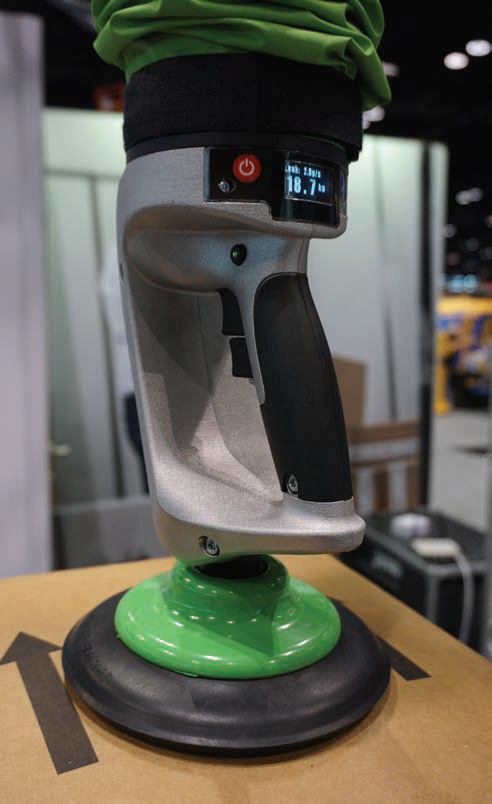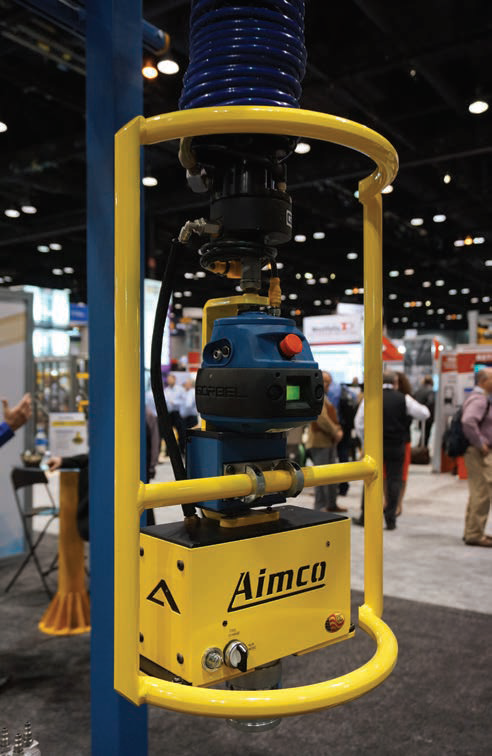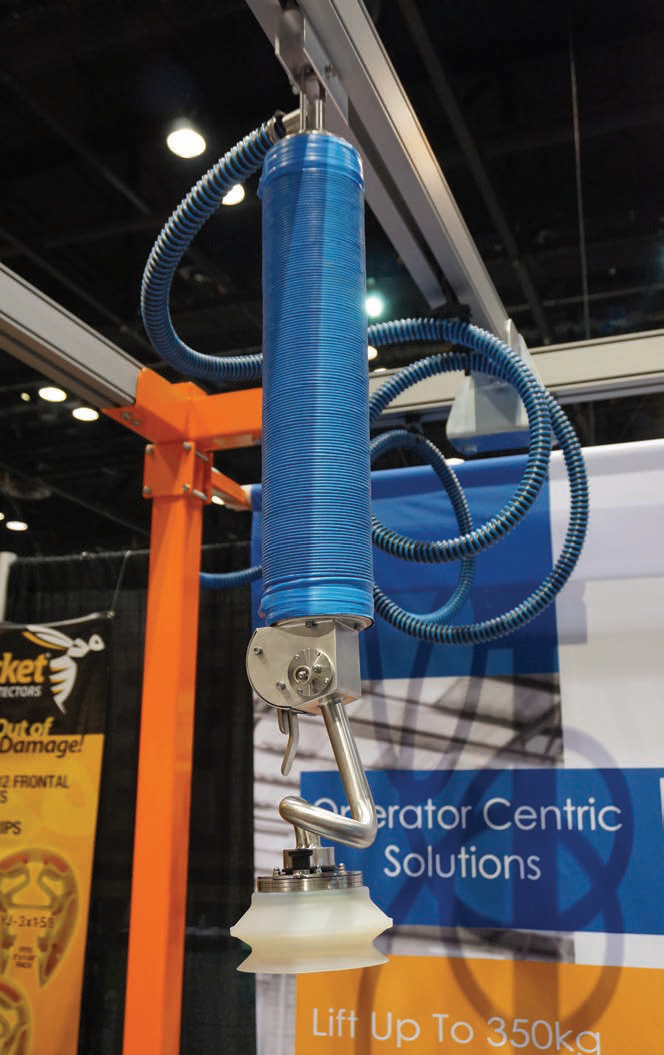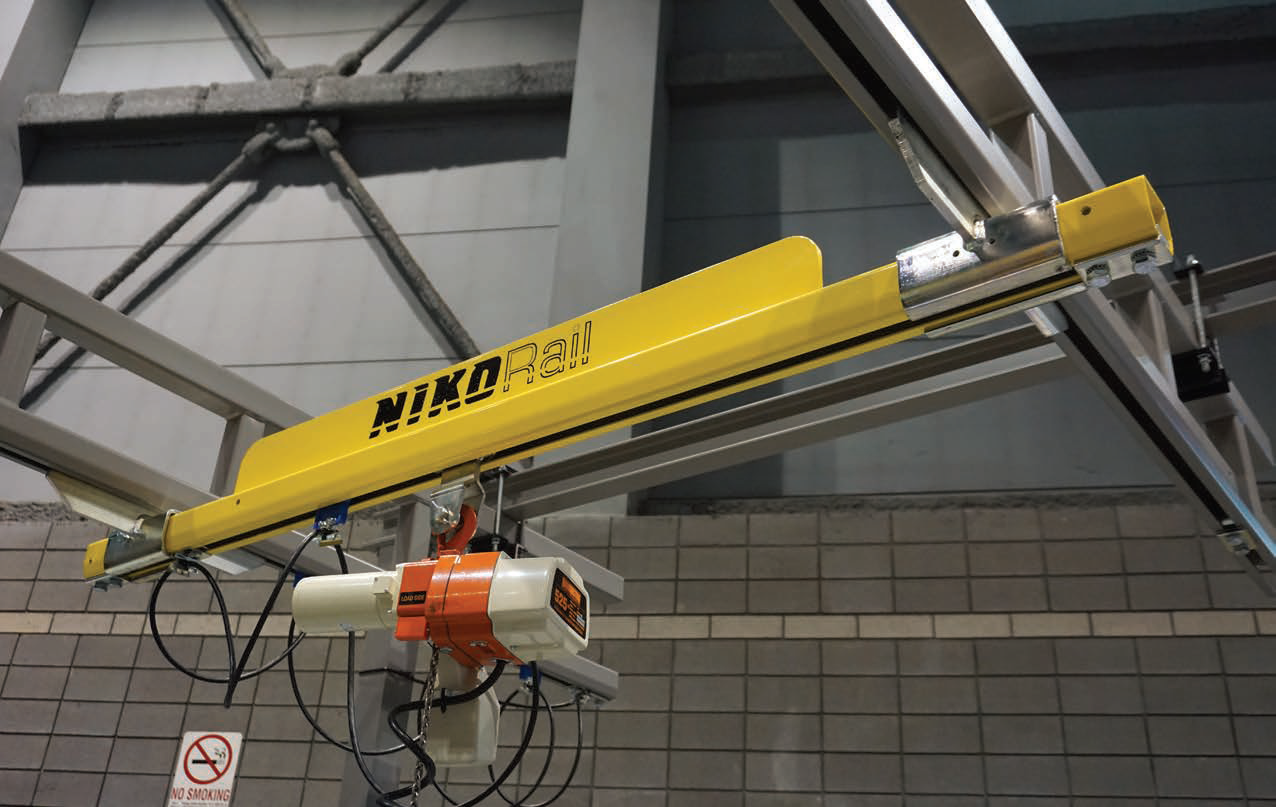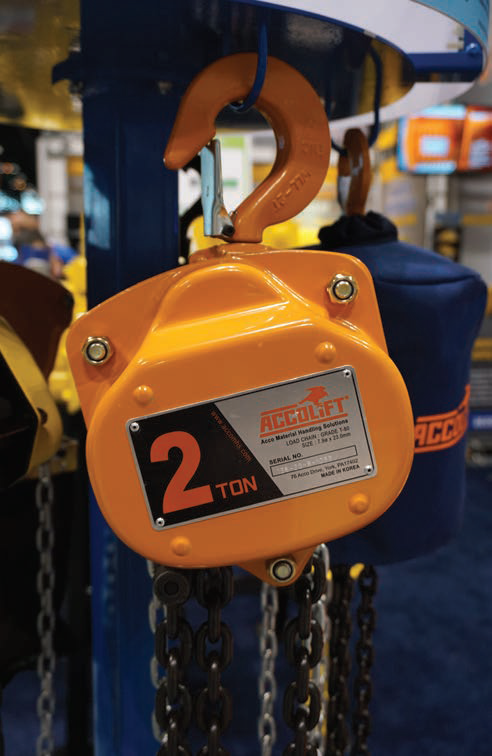Innovation showcase
19 June 2019Promat took place in Chicago in April, with crane and handling equipment manufacturers lining up alongside other members of the logistics industry. Daniel Searle attended.
Germany-based Demag celebrates its 200th anniversary this year. The company’s stand at Promat featured archive photographs of its past operations, whilst showcasing some of its present-day technology.
Centre-stage was the variable speed chain hoist, which offers capacity of up to 4,400lbs. The system is used a lot in baggage handling to improve safety and ergonomics, said Chad Donahue, district sales manager at Demag, and can also be used by left-handed or right-handed operators. It features a multihandle integrated control, and a quickdisconnect system enables multiple lifting attachments to be deployed.
An interesting development from the company, which is currently patent pending in the US, is the cantilevered workstation. It was developed for the automotive power train industry in conjunction with GM, and offers up to 1,100lbs of capacity on a 5m bridge with no supporting column on one side of the structure.
There are multiple benefits to the system, which is typically supplied with a 550lbs capacity. It is redeployable in a new facility or a new set-up at an existing facility, and the system can be anchored to the floor of a typical automotive plant with bolts, which means that companies do not need to build facilities specifically designed for holding so much weight, and no architect is required to plan the installation. These savings result in the system, although coming with a higher initial price, providing savings of around 50% during its lifetime.
The system has no limit on railway length, and combines a steel column with an aluminium crossbar—a steel crossbar can be used, but this diminishes capacity. The aluminium rails, as well as being lightweight, also offer a rolling resistance so low that the beam has to be perfectly level to prevent unwanted movement.
A T-shape variant is also available, with, for example, a metre of rail on one side as a place to hang supply lines such as air or water.
Gorbel, a manufacturer of cranes and ergonomic lifting systems, introduced new technology utilising the ‘Internet of Things’, also known as Industry 4.0—essentially, the ability of equipment to measure and record real-time performance data and connect with other equipment, to improve efficiency and workflow.
The technology will be added to the company’s G-Force actuator as part of the Q2 and IQ2 models. Due for launch in the summer, it provides the operator with dashboard information and maintenance programmes, including a connection via Gorbel’s G-Link system to the company’s analytics database, which enables Gorbel to perform preventative maintenance and analysis remotely. And for those concerned about data security, the data can be stored in ‘the cloud’ or kept within the walls of the facility.
The company is also planning to launch an upgrade to its overall G-Force operation platform. Other recent innovations include Gorbel’s foundationless jib cranes, which have capacities of up to 1t and are fixed with epoxy bolts, thereby offering savings as minimal alterations to the facility floor are required compared to conventional cranes.
Business in the US is currently strong, said Rob Beightol, marketing director at Gorbel: “Overhead material handling companies seem to be having a very solid year. The economy is very solid and is continuing to yield dividends in the manufacturing space.”
Piab was promoting the first Industry 4.0-compatible vacuum lifting system on the market, the piLIFT SMART, which now comes with the company’s IO-Link.
The technology provides a real-time digital load read-out, which helps the operator to ensure safe lifts and is also used by the system to determine the amount of power required to maintain the vacuum for each lift. This is then controlled accordingly via the unit’s frequency-driven pump, cutting overall power consumption by 76% compared with other vacuum lifters, said Markus Olofsson Carlbom, product manager at Piab’s ergonomic handling division. Keeping the air flow at a minimum also enables the system to produce almost no sound.
The control system is also designed to be very responsive, says Carlbom, and to enable gentle lowering of loads to surfaces. As well as assisting performance, the lifting data accrued is also available via a webbased platform, enabling both operator and operation to obtain live information on status.
The technology enables information to be integrated into customer systems, and could in the future be equipped with RFID readers, for control and quality checking—such as ensuring that loads are carried to the correct place, and optimising stockholding.
Ergonomically, the system requires less physical support from the operator compared to some manipulators, as a two-button interface on the handle stepless controls vertical movement. piLIFT SMART is also equipped with an automatic pick and place feature, designed to assist with hard-to-reach loads, such as when picking or placing an object deep inside a pallet or a box.
Columbus McKinnon is aiming to change the hoist market so that all hoists use a variable frequency drive, said Paul Smielecki, marketing manager at the company: “The drives have been seen as an upgrade over traditional contactor control, and they improve safety and give better performance.”
At Promat, the company showcased its Lodestar VS electric chain hoist, which features a VFD and is compatible with Columbus McKinnon’s Hi-Tech interface, a user interface that enables the operator to programme the drive via a Windows laptop or tablet, as well as providing hoist status and maintenance information. The company is also looking at adding operational data to the Hi-Tech system’s capabilities, said Smielecki, and developing a wireless set-up so the interface can be accessed through a mobile device.
Also at show was the Hurricane hoist, which features a 360° rotating head, allowing it to be operated from the side, below and above—making it suitable for a wider range of end uses. In addition Columbus McKinnon showcased their Tornado Lever hoist with its patented Sidewinder handle that offers a 30% reduction in pull force.
The newest launch from Harrington Hoists was the RY series electric wire rope hoists, which feature dual speed VFD control on both hoist and trolley, to optimise speed adjustability. A no-load high speed function allows hoist operation at 1.5 times the standard high speed when carrying a load less than 25% of the rated capacity.
The hoists, which are assembled at Harrington’s facility at Mannheim, Pennsylvania, are designed for safety, reliability and performance, as well as offering ultra-low headroom. 3t and 5t models are currently available.
At Illinois-based Handling Systems International’s (HSI) stand, the company was promoting its newly-launched NikoRail enclosed track crane system.
The system, which is available in customised set-ups with capacities up to 2t and bridge lengths up to 10m, offers a low pulling force thanks to the guide rail rolling on the inside surface of the track. The standard system is made from steel for strength, said Bret Lussow, director of business development at HSI, although an aluminium option is available.
Mike Rehor, vice president of sales and marketing at HSI, said: “We’ve partnered with Helm Hellas from Greece to provide us with the rail and a full line of hardware and components to offer some unique material handling solutions. We are bringing in the raw, roll formed steel and welding the cranes right here in our new McCook, Illinois facility.
“We have seen strong demand for enclosed track cranes over the past several years and this product compliments our dealers desire to have an alternative source and Midwest manufacturer of enclosed track cranes. Our new facility will allow us to more easily manufacture this product and service our dealers’ needs.”
The company was also promoting its aluminium gantry cranes, and its foundationless jib crane, available with capacities of up to 1t, and a height and arm length of 16ft.
Minnesota-based OZ Lifting Products featured their range of innovative davit cranes, the CompOZite and CompOZite Elite series, which use advanced composite materials to combine heavy load capacities with an ultra-lightweight design.
“Manufactured in the USA the cranes are less than half the weight than the steel equivalents while providing the same strength,” said Richard Miller at OZ. “They are pound for pound the lightest and strongest in the market.”
The carbon fibre davit crane system weighs 37lb and provides a 1,200lb capacity, enabling the crane to be transported by one person, and requires no tools to assemble, which allows for one-person assembly. The model on display at Promat was one of the first production models.
The composite crane was launched in 2014 and has had success in a variety of industries around the world, said Miller. The material is particularly suited to sectors such as wastewater, property management, aviation and boat manufacturers among others. The cranes are non-corrosive and non-conductive, and all OZ davit cranes are individually tested and certified at 125%.
Also being promoted by OZ at the show were its range of manual chain hoists, in capacities from 1/4t–30t and lever hoists from 1/4t–9t. They also offer an electric chain hoist range and an electric builder’s hoist in 500lb and 1,000lb capacities offering 90ft of lift with up to 75ft/m of lift speed.
The company also produces brake winches, beam clamps, and a patented trolley that can be set to the correct beam width without the use of washers or bolts and features a glow-in-the-dark measuring label.
New budgets boost business
At Sky Hook, a manufacturer of mobile and fixed jib cranes, business is booming. “Business is up 30% this year, mostly through North American customers,” said Twilla Christensen at the company. “There was uncertainty around the China market last year, and business slowed in the summer, but we’ve been consistently busy since September 2018.
“The tax relief measures are now having an effect—when they were first introduced, annual budgets had already been set, so they didn’t have an immediate impact. The new budgets that take into account tax relief are now coming into play.”
One issue that had to be navigated was the increased steel price, said Christensen: “The steel price rose 150% in four months last year, but it’s since levelled off. It tends to be higher in Q1 and level off in May—we’ve seen some increases this year, but not huge ones. The price of certain components such as bearings and chains were particularly affected by the tariffs.”
The company recently introduced its new website, tailored to guide customers through all the equipment and options offered by Sky Hook. Later this year the company plans to update its standard range of cranes to add the ergonomic features currently available on custom systems.
Acco presented two additions to its Accolift brand, a hand chain hoist available with capacities from 1/2t–20t, and a lever chain hoist with capacities from 3/4t–9t. The lever chain hoist offers features including an optional slip clutch, an overload device as standard, hook storage, and the ability to freewheel for manual free chaining, where previous systems had to be ratchet chained.
The hand chain hoist is designed to be portable and lightweight, and is suitable for a range of applications at machine shops, industrial maintenance facilities, construction sites, and production environments. The lever hoist increases the operator’s efficiency in manipulating loads and is aimed at sectors including industrial, maintenance, mining, shipbuilding, construction and utilities.
R on I, based in North Carolina, promoted a new aluminium rail system that was due to launch shortly after Promat. It features a new profile and new components, and is easier to join than previous systems, with the rail able to be spliced anywhere along its length, not just at a suspension point. It is also smoother, said sales manager Bret Wachter, with no extrusion on the outside, eliminating areas where dust could potentially gather and therefore making it better for sectors where cleanliness is key such as food and pharmaceuticals.
Palamatic, which has its US operations based in Garner, North Carolina, showcased its Flex Lite lifting system, for picking and manoeuvring loads up to 100lb.
The company has its headquarters in Chesterfield, UK, and designs bespoke lifting systems, attachments and grippers for its customers, focusing primarily on vacuum systems, said Mark Stantz, USA sales technical support engineer at the company. These are used for a range of applications such as lifting reels, barrels, sheets and so forth, accommodating loads up to 650lb.
And TAWI promoted its mobile order picker—a lifting system, with vacuum handling attachment on an articulating arm, that can be picked up and moved with a forklift.
“More and more, distribution centres are coming to us and asking for mobile picking,” said TAWI president Michael Lee. “Our mobile order picker offers a return on investment as it prevents injuries, as there is a limit to the amount of weight one person can pick up.”
Launched in December, the system is targeted at warehouses and distribution centres. The current make-up of the US workforce is boosting business at the company, said Lee:
“We’re currently seeing 40% a year growth. The risk and cost of manual lifting is much higher than it was. And, companies want lifting systems that are easy for anyone to use—because of the low unemployment in the US, companies cannot always get an experienced lifter in.”

